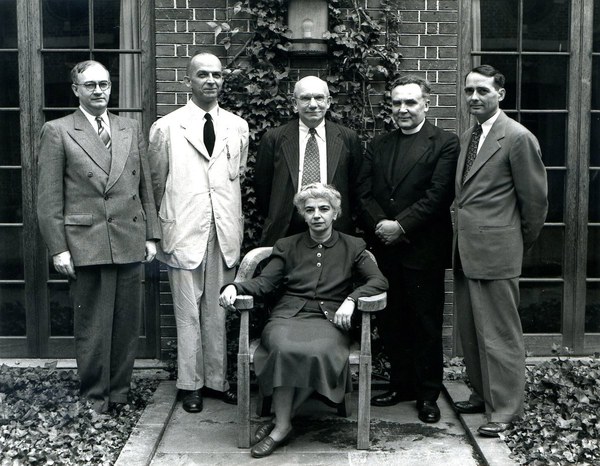Speakers at the 1948 Byzantine Studies symposium, left to right: Milton Anastos, Glanville Downey, Albert M. Friend Jr., Francis Dvornik, Paul Underwood, and Sirarpie Der Nersessian (seated).
Milton Vasil Anastos, who received his PhD in history from Harvard University and was professor of classics and Byzantine history, was associated with Dumbarton Oaks for twenty-three years. At Dumbarton Oaks, he was a junior fellow (1941–44), a fellow (1944–46), assistant professor of Byzantine theology (1946–51), associate professor of Byzantine theology (1951–60), and professor of Byzantine theology (1960–64). In 1964, he joined the faculty of the Department of Classics and History at the University of California, Los Angeles. Anastos wrote “Dumbarton Oaks and Byzantine Studies, a Personal Account,” for the celebration of Dumbarton Oaks’ fiftieth anniversary in 1990. The following are excerpts from the 1992 publication of his remarks:
This . . . is published to commemorate the extraordinary vision and generosity of Ambassador and Mrs. Robert Woods Bliss, whose munificent endowment has made Dumbarton Oaks and all its activities possible. The endowment was of such magnitude as to deserve a special niche in the history of philanthropy. But it also had an unusual personal dimension. The donors had a deep concern for the implementation of their ideals and high regard for the persons who had been chosen to carry them out. This was manifested in many ways, as, for example, in the ritual of afternoon tea, which was served every weekday at 5 p.m. and regularly attended by Mrs. Bliss when she was in Washington, and from time to time by Mr. Bliss as well, both of whom engaged in lively conversation with those present. . . .
The primacy of Dumbarton Oaks in Byzantine studies has many facets. First and foremost is the magnificent library of 107,623 volumes, presided over by a number of devoted librarians, notably scholars like George Soulis, Glanville Downey, Carl H. Kraeling, Merlin Packard, and the present incumbent, Irene Vaslef.
On an equal plane is the museum of 1,492 judiciously chosen objects, wisely administered over the years, first by Elizabeth Bland, then by Susan A. Boyd, and now resplendent after its recent refurbishment. This great treasury includes collections of 11,700 coins and 13,000 seals. . . .
In the first three years a number of renowned scholars were appointed to the senior staff. But a new era began with the election in 1943 of Professor Albert M. Friend, Jr., of Princeton University to the Board of Scholars. . . .
He became Resident Scholar in 1944, and thenceforth until his death in 1956, under a variety of titles, acted as Director of Studies at Dumbarton Oaks, although remaining Marquand Professor of Art and Archaeology at Princeton University and thus holding the unique position of a Princeton professor who was at the same time the head of a Harvard department. He soon realized that Dumbarton Oaks would function more efficiently if its senior Byzantinists were organized as a department of Harvard University, given academic rank, and made members of the Faculty of Arts and Sciences. With the support of Paul H. Buck, Provost of the University, he won approval for this plan from the Corporation, and was enabled to appoint professors of Byzantine architecture, art, history, literature, and theology, who from time to time gave courses in their specialties in Cambridge. . . .
Friend’s system of organization was a conspicuous success. But, with the passing of time, and the decrease in the size of the research faculty as a result of deaths and resignations, a new situation arose which required some changes. These were instituted by Professor Giles Constable (Director, 1977–84), a prolific author and specialist in Western medieval history, who decided not to fill vacancies in the permanent professional staff. Instead, he conceived the idea of awarding junior fellowships for research at Dumbarton Oaks combined with part-time, nontenure teaching appointments in universities and colleges which had not hitherto presented courses on Byzantium. This plan, which has been widely adopted, has led to a noteworthy increase in opportunities for the study of Byzantine civilization in the United States.
—M. Anastos, in Byzantium, A World Civilization, edited by Angeliki E. Laiou and Henry Maguire (Washington, D.C., 1992), 5–9.

